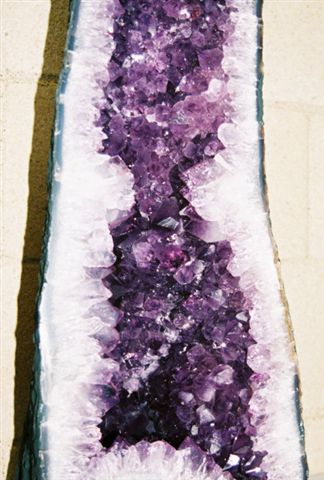Take Me Home
Take Me Shopping
Dreams
Inner Sight/Intuition
Mind Altering Substances
More Articles
Spiritual Cinema
Book Recommendations
Movie Recommendations
Music Recommendations
Quotes
Amethyst Cathedral Grading
Amethyst - General Information
Amethyst - Mystical Lore
Amethyst Cathedral in Stock
The Color Indigo
Photos
All Products

Amethyst - General Information
Amethyst (quartz crystal) can be found in many regions around the world. Amethyst crystal is found in Mexico, Brazil, Canada, Uruguay, Africa, Europe and the United States.
Quartz is the most common mineral on earth. Amethyst is the most valuable form of quartz. Amethyst is found globally and is easily available. For this reason, amethyst prices are affordable. The quality of amethyst differs by its locality. For example, African amethyst is small, but carries a high saturation in color. Australia is also home to dark, highly saturated amethyst. Amethyst has been found in great quantities in Brazil.
The formation of amethyst geodes occur in igneous and metamorphic rocks. These geode crystals are given their purple tones by manganese. Amethyst crystal sometimes occurs in faults and ancient cracks in rock structure. Geode crystals also occur in volcanic gas bubbles.
Amethyst cathedrals (amethyst churches) are typically found in Brazil and Uruguay. The most notable sources of amethyst cathedral geodes in Brazil come from Minas Gerais, Rio Grande do Sul, Bahia and Maraba. These amethyst crystals are found in vugs. Vugs are small cavities in rocks that are lined with crystals. These geode rocks containing amethyst crystal are often formed by volcanic material. Vugs were often formed from lava and magmatic flow over trees or gas bubbles created by heat convection. The amethyst crystals produced in these areas vary in color saturation.
Amethyst from Uruguay vary in saturation from a medium saturated purple to a deep and highly saturated purple. Uruguayn amethyst is considered the darkest and deepest purple available. Similar to Brazil, amethyst geode crystals are also found in volcanic vugs in Uruguay. The larger Uruguayan vugs contain stalactites and other formations on which amethyst druses form.
Two main sources of amethyst from Mexico include Vera Cruz and Guerrero, Mexico. Amethyst from Vera Cruz has a tendency to be of lighter shades and typically clear. Amethyst from Guerrero is typically deep and a highly saturated dark purple.
Thunder Bay is one of the major sources for Canadian amethyst which is typically mined as crystal druses. Amethyst druze is a cluster of small points. The color unique to Canada includes a reddish inclusion slightly under the surface of each crystal. Amethyst is known as the gemstone of Ontario.
Among the African countries that mine amethyst are Zambia and Namibia. Amethyst druses from Africa contain small crystals of fully saturated color and wonderful clarity.
The United States is home to amethyst deposits in several states, including: Maine, Pennsylvania, North Carolina, South Carolina, Montana, Colorado, Georgia, Arizona, Rhode Island and Virginia. They range in color from medium to high saturation. Amethyst is the state gemstone for South Carolina.
Italy and Germany are two of Europe's most notable sites for amethyst. Italy's amethyst crystals are of evenly distributed saturation. German amethyst is often pale in color and is found coupled with other forms of crystal such as agates.
Amethyst can be found in other countries around the world, including: Bolivia, Argentina, Madagascar, India and Sri Lanka.
Amethyst is a variety of quartz which naturally occurs in crystal form. These crystals can be found in clusters (or druse) in a geode rock. Amethyst ranges in shades of purple from pale lavender and lilac to a deep intense purple.
The color of amethyst crystals vary in shades of purple. This form of quartz must be purple to be an amethyst. However, the shades can include a reddish and milky purple quality. The purple color comes from the existence of manganese in clear quartz. The presence of iron determines the intensity of its purple color. Amethyst also ranges from transparent to almost translucent.
The chemical name for amethyst is Silicon Dioxide (SiO2). The color of each amethyst crystal depends upon the distribution of color-filled bands within it. These bands are stable only at temperatures below 480 degrees F (248.9 degrees C). The amethyst stone should be protected from extreme heat in order to prevent fading. However, professional heating treatments have been used on amethyst to produce the gems known as citrine and ametrine (400 and 500 degrees C). Many naturally occurring citrines began as amethyst and were created from exposure to lava and magma. Ametrine has become a popular gemstone which is half amethyst and half citrine.
Other Characteristics of Amethyst:
Index of refraction: 1.5-1.6
Birefringence: 0.01
Mohs' Scale Hardness: 7
Fracture: Conchoidal
Specific Gravity: 6.5
Crystal System: Tetrahedral


